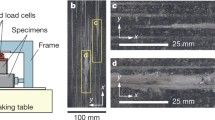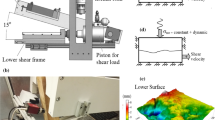Summary
Laboratory room temperature triaxial friction tests on sawcut granite and serpentinite specimens suggest that stick-slip at high confining pressures is preceded by dilatancy in the intact rock adjacent to the shear surface. By using a fast-reacting servo-loading system in combination with a high resolution digital computer recording system it is possible to obtain a more realistic picture of the stick-slip mechanisms and the stress drop associated with unstable slip. Fracturing in granite under biaxial loading leads to a significant anisotropy in dilation andP-wave velocity of the rock. Velocity decreases remarkably in the directions of minor principal stresses with no indication for velocity recovery before macroscopic shear fracture development.
The results suggest that dilatancy and velocity anomalies may precede crustal earthquakes under certain tectonic conditions.
Zusammenfassung
Triaxiale Scherversuche an polierten Scherflächen in Granit- und Serpentinitproben (Normaltemperatur) lassen schließen, daß instabile Gleitvorgänge auf den Scherflächen bei sehr hohen Manteldrücken mit vorhergehenden Auflockerungen (Dialatanz) des intakten Gesteins in der Umgebung der Scherfläche verbunden sind. Durch die Verwendung eines reaktions-schnellen Servobelastungssystems in Verbindung mit einem hoch-auflösenden digitalen Aufzeichnungssystem konnte erstmals ein Einblick in den tatsächlichen Ablauf des instabilen Gleitprozesses gewonnen werden. Der Bruch in Granit bei biaxialer Belastung führt zu einer signifikanten Anisotropie der Auflockerung des Gesteinsgefüges und damit der Geschwindigkeit seismischer Wellen. Die Geschwindigkeit derP-Wellen nimmt in Richtung der beiden kleineren Hauptspannungen mit fortschreitender Deformation kontinuferlich ohne Anzeichen eines Geschwindigkeitsanstiegs vor der Entwicklung des makroskopischen Scherbruchs ab.
Die Ergebnisse lassen den Schluß zu, daß Dilatanz und damit verbundene Geschwindigkeitsanomalien Erdbeben in der Kruste bei bestimmten tektonischen Bedingungen vorangehen können.
Similar content being viewed by others
References
Nur, A. (1972),Ditatancy, pore fluids and premonitory variations of t s/tp travel times. Bull. Seis. Soc. of America62, 1217–1222.
Aggerval, Y. P., Syks, L. R., Armbruster, J. andSbar, M. L. (1973),Premonitory Changes in Seismic velocities and prediction of earthquakes. Nature241, 101–104.
Anderson, D. L. andWhitcomb, J. H.,The dilatancy-diffusion model of earthquake prediction in Proc. Conf. Tectonic Problems of San Andreas Fault System, ed. by Kovach and Nur, Stanf. Univ. Press, 1973, 417–426.
Rummel, F.,Changes in the P-wave velocity with increasing inelastic deformation in rock specimens under compression, Advances in Rock Mechanics, National Academy of Sciences, Washington, 1974, 517–523.
Hadley, K. (1975),V p/Vs anomalies in dilatant rock samples, Pageoph113, 1–23.
Bonner, B. P. (1975),V p/Vs in saturated granodiorite loaded to failure, Pageoph113, 25–29.
Lockner, D., andByerlee, J. (1977),Acoustic emission and fault formation in rocks. Proc. 1st. Conf. A.E., Microseismic Activity in Geol. Structures and Mat., ed. H. R. Hardy and F. W. Leighton, Ser. Rock and Soil Mech.2, 1974–77, Trans Tech. Publ.3, 99–107.
Rothman, R. L. (1977),Acoustic emissions in rocks stressed to failure. Proc. 1st. Conf. A. E., Microseism. Act. in Geol. Structures and Mat., ed. H. R. Hardy and F. W. Leighton, Ser. Rock and Soil Mech.,2, 1974–77, Trans Tech. Publ.3, 109–133.
Crouch, S. L. (1970),Experimental determination of volumetric strains in failed rock. Int. J. Rock Mech. Min. Sci.7, 589–603.
Friedman, M. (1974),Mechanical properties of rocks affecting earthquake prediction and control. Semi-annual progr. rep. Center for Tectonophys. Texas A and M Univ., College Station, 1974.
Brace, W. F. andByerlee, J. D. (1970),California earthquakes: Why only shallow focus? Science168, S.1573–1575.
Brace, W. F. (1972),Laboratory studies of stick-slip and their application to earthquakes, Tectonophysics14 3/4, 189–200.
Byerlee, J. D. (1970),The mechanics of stick-slip, Tectonophysics9, 457–486.
Sobolev, G. A. (1975),The Study of precursors of failure under biaxial compression, Pageoph113, 45–49.
Rummel, F. (1975),Experimentelle Untersuchungen zum Bruchvorgang in Gesteinen, Ber. Inst. f. Geophysik Ruhr-Universität Bochum,4.
Stesky, R. M., Brace, W. F., Rilfy, D. R. andRobin, P. Y. F. (1974),Friction in faulted rock at high temperature and pressure, Tectonophysics23, 177–203.
Engelder, J. T., Logan, J. M. andHandin, J. (1975),The sliding characteristics of sandstone on quartz fault-gouge, Pageoph113, 69–86.
Author information
Authors and Affiliations
Rights and permissions
About this article
Cite this article
Rummel, F., Alheid, H.J. & Frohn, C. Dilatancy and fracture induced velocity changes in rock and their relation to frictional sliding. PAGEOPH 116, 743–764 (1978). https://doi.org/10.1007/BF00876536
Received:
Issue Date:
DOI: https://doi.org/10.1007/BF00876536




